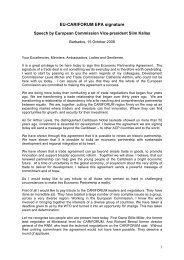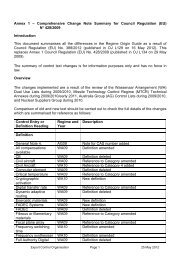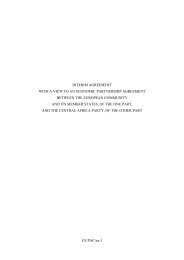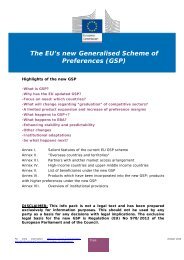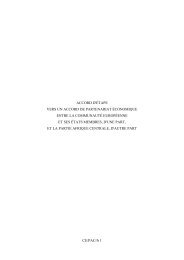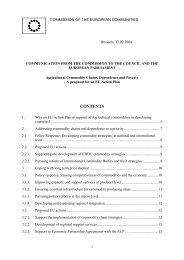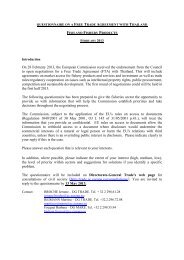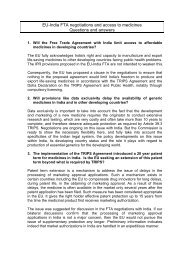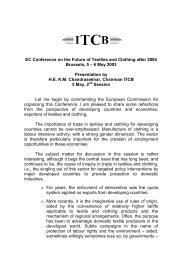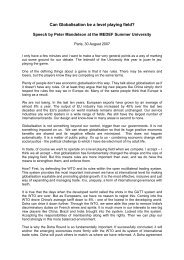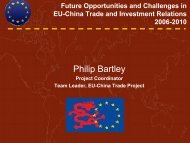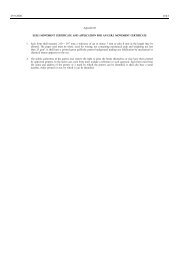Report on the Implementation of the derogation to ... - Trade Websites
Report on the Implementation of the derogation to ... - Trade Websites
Report on the Implementation of the derogation to ... - Trade Websites
Create successful ePaper yourself
Turn your PDF publications into a flip-book with our unique Google optimized e-Paper software.
Final <str<strong>on</strong>g>Report</str<strong>on</strong>g><br />
RoO Derogati<strong>on</strong> under <strong>the</strong> PACP-IEPA<br />
• The <strong>on</strong>going (and potential increase) <strong>of</strong> government subsidies <strong>to</strong> support domestic fishing<br />
industries and nati<strong>on</strong>al c<strong>on</strong>sumpti<strong>on</strong>, especially with <strong>the</strong> likely collapse <strong>of</strong> proposed fisheries<br />
subsidies disciplines under <strong>the</strong> Doha Round at <strong>the</strong> WTO.<br />
• The growing importance <strong>of</strong> envir<strong>on</strong>mental sustainability policies and awareness, especially<br />
am<strong>on</strong>g retailers and c<strong>on</strong>sumers <strong>of</strong> fish in Nor<strong>the</strong>rn Europe, which may result in c<strong>on</strong>tinued<br />
shifts in emphasis <strong>on</strong> fishing methods. The largest potential development here is <strong>the</strong> recent<br />
MSC certificati<strong>on</strong> <strong>of</strong> <strong>the</strong> PNA purse seine skipjack fishery.<br />
Note that trade volumes and values do not capture species compositi<strong>on</strong> <strong>of</strong> product because EU<br />
trade data do not effectively capture this. 308 As such, as per Secti<strong>on</strong> 6.1, markets are characterised as<br />
being predominantly ei<strong>the</strong>r canned yellowfin or canned skipjack.<br />
6.8.1 Projecting PNG exports: data and assumpti<strong>on</strong>s<br />
The following discusses current and potential future impacts <strong>on</strong> <strong>the</strong> EU Distant Water Fleet and,<br />
respectively, EU-based and third country processors and <strong>the</strong>ir markets within <strong>the</strong> EU. Each <strong>of</strong> <strong>the</strong>se<br />
three sets <strong>of</strong> players is assessed according <strong>to</strong> two time-frames <strong>of</strong> impacts:<br />
1. From March 2008 <strong>to</strong> present (i.e. from when PNG first notified <strong>the</strong> EU under <strong>the</strong> PACP-EU<br />
IEPA Pro<strong>to</strong>col II, Article 6.6(b), triggering <strong>the</strong> three-year review clause in <strong>the</strong> derogati<strong>on</strong>, <strong>of</strong><br />
which this study is a part (see Secti<strong>on</strong> 2)).<br />
2. In <strong>the</strong> medium term (<strong>to</strong> 2016), selected as a period <strong>of</strong> time where some reas<strong>on</strong>able<br />
assumpti<strong>on</strong>s around potential PNG exports could be developed (see Table 6.11 which is<br />
based up<strong>on</strong> Table 3.13).<br />
The medium-term scenario is based up<strong>on</strong> a realistic interpretati<strong>on</strong> <strong>of</strong> planned increases in<br />
producti<strong>on</strong> and export strategies by existing and planned processing facilities in PNG for 2016. It<br />
forms <strong>the</strong> basis for <strong>the</strong> quantitative comp<strong>on</strong>ents <strong>of</strong> <strong>the</strong> following analysis <strong>of</strong> medium-term market<br />
and industry impacts <strong>of</strong> <strong>the</strong> derogati<strong>on</strong>.<br />
The <strong>to</strong>tal estimated raw material throughput requirements for <strong>the</strong> PNG export scenario in Table 6.11<br />
are 182,500 mt (or ~113,150 mt for canned tuna and 69,350 mt for tuna loins). This estimate <strong>of</strong> raw<br />
material needs is for all markets, including domestic sales and o<strong>the</strong>r export markets (e.g. <strong>the</strong> US),<br />
and does not equate <strong>to</strong> <strong>to</strong>tal raw material used in processed exports <strong>to</strong> <strong>the</strong> EU.<br />
308 HS codes do formally differentiate between types and species <strong>of</strong> products, but it is believed that <strong>the</strong>y are<br />
not universally applied by cus<strong>to</strong>ms authorities <strong>to</strong> differentiate between species. (See note <strong>to</strong> Table 6.4.)<br />
Linpico s.a.r.l. Page 150




